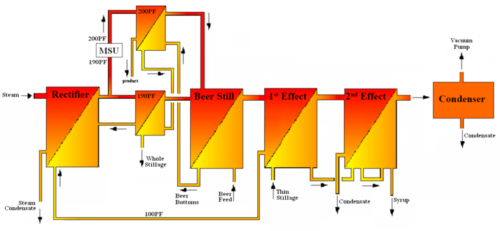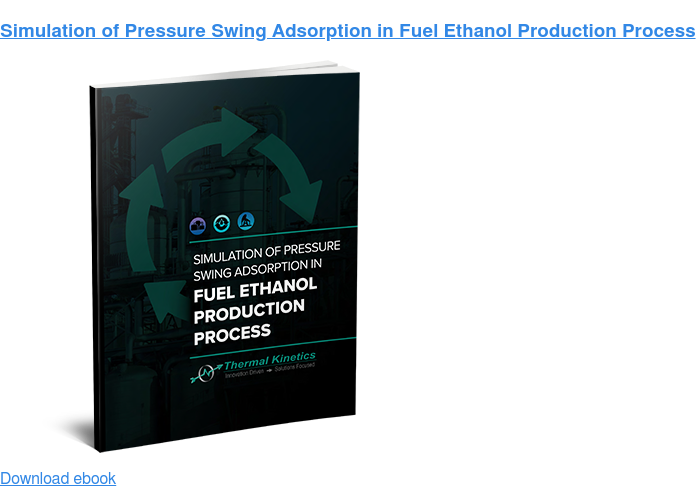Fuel Ethanol Processing: Understanding Distillation, Dehydration, and Evaporation (DD&E)
Distillation, dehydration, and evaporation systems, often referred to simply as DD&E, are the cornerstones of nearly every standard dry mill ethanol plant. Although they’re often energy-intensive, DD&E systems serve as indispensable central processing areas for fuel ethanol production.
Fuel ethanol production traditionally begins with beer, used as the source of the ethanol, which is fermented in large fermentation containers. From there, the production process moves through each of the above-listed steps — distillation, dehydration, and finally, evaporation — allowing for the creation of high-quality, fuel-grade ethanol as well as valuable animal feed.
The DD&E Process
This section of the fuel ethanol plant is highly integrated to minimize energy required to recover pure ethanol and remove water from the beer solids. The three basic unit operations of distillation, evaporation, and dehydration are all heat transfer and mass transfer operations.
Evaporation removes a single volatile component (water) while distillation separates two or more volatile components (water, ethanol, and higher molecular weight alcohols). Dehydration is achieved by use of Zeolites, an adsorbent material which works by virtue of a strong surface attraction between the Zeolite and water.
Distillation in production of fuel ethanol makes use of the difference in the volatility of ethanol and water. Ethanol vaporizes at a much lower temperature than water such that if a beer containing 13 wt% ethanol is boiled the vapor over the liquid will contain as much as 50% ethanol.
A distillation column consists of trays or packing with vapor traveling from the bottom to the top and liquid flowing from the top to the bottom. Upon each tray from the top to the bottom the liquid loses a portion of its ethanol and the vapor becomes more enriched in ethanol.
However one unique feature of water and ethanol is that they can only be separated to about 95% ethanol at which point ethanol and water have the same volatility. This composition is called an azeotrope and further removal of water from the ethanol requires a different process which is where dehydration using molecular sieves (Zeolite) comes into play.
So putting the full process together, distillation separates ethanol from the beer resulting in an azeotropic mixture of water and ethanol which is further separated by dehydration using molecular sieves while the beer depleted of ethanol is processed to remove particulate solids and the dissolved solids remaining are concentrated by evaporation.
Thermal Kinetics, DD&E process combines these operations in the most energy efficient manner.
DD&E Technology
Thermal Kinetics DD&E process first removes carbon dioxide from the beer before feeding the beer to the top of a stripping column referred to as the Beer Column. Ethanol is removed from the beer in this distillation column with 55% ethanol vapor recovered from the top supplying heat to a multiple effect evaporator.
The liquid at the bottom of the Beer Column called whole stillage contains dissolved and suspended solids which are the remains of corn kernels or other grain used in making the beer. This bottom stream is centrifuged recovering a solids cake and a dissolved solids stream called thin stillage. The thin stillage is further concentrated in the evaporator for production of an animal feed.
The 55% ethanol vapor condensed in the evaporator is sent to another distillation producing the azeotrope and then to the Molecular Sieve Pressure Swing Adsorption dehydration system.
The following equipment is utilized in fuel ethanol processing:
- A carbon dioxide flash system and beer preheating unit
- A beer column with overhead vapor providing heat to concentrate thin stillage
- A multiple effect evaporator concentrating the thin stillage producing a concentrate called syrup to blend with the wet solids cake and be fed to the dryer.
- A condenser able to operate below atmospheric pressure in order to keep the evaporation process below atmospheric pressure and at very low temperature to control fouling
- A centrifuge to separate beer suspended solids and dissolved solids which the resulting solids cake feeding a dryer and the thin stillage feeding the evaporator
- A rectifying column to distill ethanol from the condenser beer column overheads recovering water at the bottom and azeotropic vapor at the top of which on third is sent to dehydration and two thirds is condensed in the beer column reboiler.
- A molecular sieve dehydration system to produce dry ethanol which is condensed in a second beer column reboiler
Heat for the system is supplied to the rectification column which provides heat for dehydration and the beer column which in turns provides heat to the evaporator. This effectively reuses the primary steam heat four to five times for a highly energy efficient operation.
The Benefits of DD&E Systems
As a leader in the production of state-of-the-art DD&E systems, Thermal Kinetics has innovated numerous patented improvements for standard DD&E processes to make the production of fuel ethanol more efficient and cost-effective.
Thermal Kinetics DD&E systems allow for the following benefits:
- Lower “backset” or fermentation recycling, with a 57.3% flow reduction
- Great improvements in the removal of fuel oils (higher alcohols)
- Significantly lower energy usage, including:
- 21% lower usage with standard 12-13.5% w/w ethanol feed concentrations
- 31% lower usage when used with 15% w/w ethanol feedstock
- A 56.5% gain in condensate recovery, allowing for better condensate reuse
- Significant improvements in processing whole stillage, including:
- Increased solid concentrations feeding the centrifuges
- 20% centrifuge load reduction
- Enhanced thin stillage concentrations
- Lower evaporation system operating temperatures, which reduce fouling and increase productivity in between regular maintenance procedures
 To learn more about DD&E, download Thermal Kinetics’ technical paper, “Simulation of Pressure Swing Adsorption in Fuel Ethanol Production Process” and visit our website patents page “Advanced Fuel Ethanol Process”.
To learn more about DD&E, download Thermal Kinetics’ technical paper, “Simulation of Pressure Swing Adsorption in Fuel Ethanol Production Process” and visit our website patents page “Advanced Fuel Ethanol Process”.


